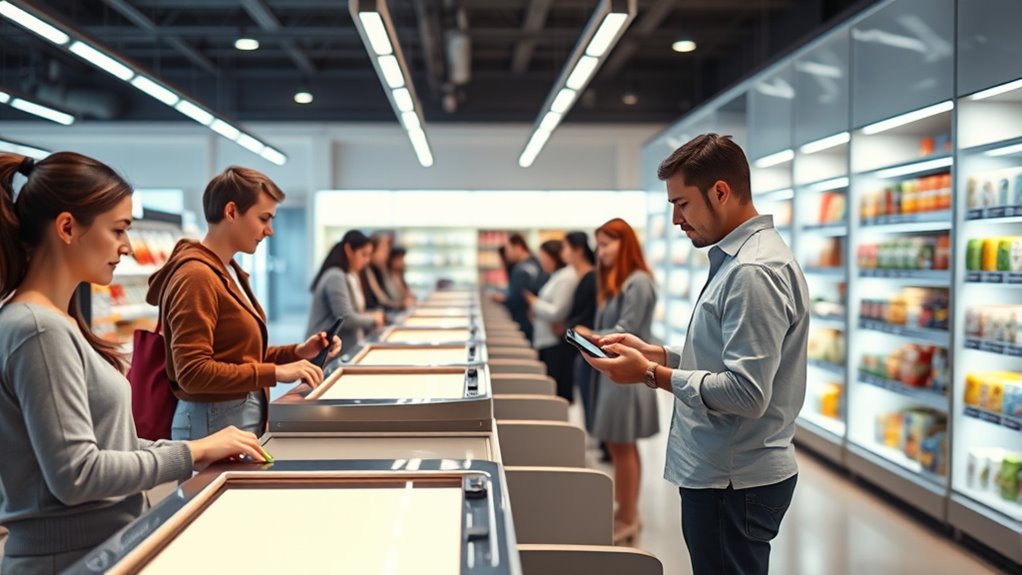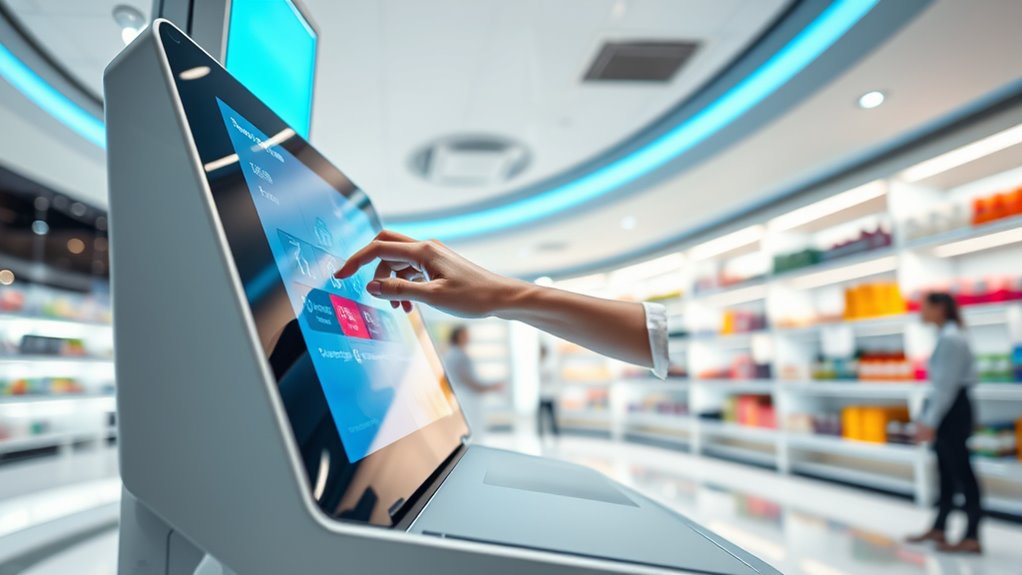Self-service checkouts are quickly becoming the future of retail payments, with over 75% of stores adopting these systems to boost speed and convenience. As consumer preferences lean towards quick, contactless experiences, and retailers invest heavily in technology, self-checkouts help handle higher volumes efficiently. While some shoppers still prefer human assistance, the trend shows these machines will continue to grow in importance. Explore further to see how these innovations are shaping retail’s next chapter.
Key Takeaways
- Self-service checkouts are rapidly expanding, projected to reach over 75% of retail stores by 2030.
- Consumers, especially Millennials and Gen Z, prefer quick, contactless, and digital payment options.
- Technological innovations improve efficiency, security, and integration with omnichannel retail strategies.
- Challenges include technology adaptation issues and initial investment costs, but benefits often outweigh these concerns.
- Overall, self-service checkouts are becoming central to retail operations, shaping the future of payments and shopping experiences.

Have you noticed how self-service checkouts are transforming the retail landscape? These systems are now a dominant feature in stores worldwide, reshaping how you shop and how retailers operate. Valued at USD 5.84 billion in 2025, the market is projected to nearly double to USD 11.09 billion by 2030, growing at a rapid CAGR of 13.68%. This surge is driven by your increasing desire for contactless, convenient shopping experiences. Retailers are investing heavily in R&D, partnering with technology providers, and acquiring new companies to stay competitive in this fast-evolving space. With high competition among industry giants like Diebold Nixdorf, Fujitsu, NCR, and Toshiba, ongoing innovation is essential. These companies are constantly refining contactless payments, user interfaces, and transaction speed, ensuring that self-checkout systems become more seamless and accessible.
Self-checkout systems are revolutionizing retail through innovation and fierce industry competition.
You’ll find self-checkout kiosks in about 75.5% of retail stores, with 96% of grocery stores offering these options. Globally, over 10,000 retailers installed self-checkout systems by 2024, and this number is expected to more than double to over 24,000 stores by 2030. This prevalence indicates that self-service has become an integral part of store layouts and retail strategies, helping stores handle higher customer volumes efficiently. Your preference for quick, hassle-free shopping is fueling this growth—80% of shoppers favor non-traditional checkout methods, and 66% consider self-checkout the ideal choice. Millennials and Gen Z, in particular, show a strong affinity for these systems, valuing speed, convenience, and minimal interaction.
The technological landscape supports this shift, with companies continuously enhancing features like contactless payments and user-friendly designs. Despite high barriers to entry, new players are entering the market, driven by consumer demand. Retailers benefit from these systems by reducing labor costs, increasing throughput, and decreasing queue times. Automated transactions streamline operations and support omnichannel strategies, integrating online and offline experiences. Plus, they enable data collection that helps with marketing, inventory management, and personalized offers. Additionally, the development of advanced payment technologies is further accelerating adoption by making transactions faster and more secure.
For you as a shopper, self-service checkouts offer immediate benefits. You can process returns and exchanges quickly, access digital tracking, and receive personalized shopping carts via email. These features cater to your preference for minimal contact, especially during times when safety is a concern. Automation also reduces the need for staff intervention, lowering service costs and improving overall efficiency. According to recent research, the market size of self-checkout systems is projected to grow significantly, reflecting their increasing adoption across various regions and industries.
However, these systems aren’t perfect. Some shoppers struggle with technology, leading to frustration. There’s also the risk of theft or shrinkage if systems aren’t properly monitored. Retailers must balance automation with human assistance for complex transactions. Initial setup and ongoing maintenance require significant investment, and not everyone prefers the digital experience. Still, the overall trend points toward a future where self-service checkouts are central to retail, offering speed, convenience, and operational efficiency that align with your evolving shopping preferences.
Frequently Asked Questions
How Do Self-Service Checkouts Handle Age-Restricted or Alcohol Purchases?
You’re curious about how self-service checkouts manage age-restricted or alcohol purchases. They use AI-powered facial age estimation to verify your age quickly and accurately, reducing the need for staff intervention. Customers can opt for facial recognition, which speeds up the process and enhances privacy. If you’re underage or prefer not to utilize facial recognition, stores often offer alternative methods like manual ID checks or staffed lanes to ensure compliance and safety.
What Are the Maintenance Costs Associated With Self-Service Checkout Machines?
You need to contemplate that self-service checkout maintenance costs vary widely. Basic units cost around $1,500 to $20,000+ initially, with annual support costs about $1,000 each. Machines with cash handling or advanced features may cost more to maintain due to mechanical complexity and frequent repairs. Don’t forget hidden costs like staff troubleshooting, system updates, and wear-and-tear on components, all of which add to your ongoing expenses.
How Do Self-Service Checkouts Impact Store Staffing Levels?
You notice that self-service checkouts often lead to lower store staffing levels. Retailers cut staff to save costs, relying more on automation. This results in fewer cashiers and more understaffed shifts, which can increase stress for workers and reduce customer service quality. While self-checkouts streamline shopping, they also shift workload onto remaining staff, making stores leaner and sometimes harder to manage effectively.
Are There Privacy Concerns With Data Collected During Self-Checkout Transactions?
Imagine your shopping trip as a story, with every item scanned revealing more about you. During self-checkouts, your data—what you buy, how often, and when—is collected silently behind the scenes. You might not see it, but your habits are mapped and stored. This raises privacy concerns, especially if data is shared without your knowledge or consent, making transparency and control more important than ever.
How Do Self-Service Checkouts Accommodate Customers With Disabilities?
You might wonder how self-service checkouts support customers with disabilities. They include features like audio output for the visually impaired, tactile buttons, and high-contrast screens. Adjustable heights and ample space assist mobility needs. Visual cues, captioning, and speech options help those with hearing or communication challenges. However, not all systems meet accessibility standards, so ongoing improvements are vital to guarantee everyone can use self-checkout confidently and independently.
Conclusion
As you stand before these self-service checkouts, you’re holding the key to the future—an open door to efficiency and independence. These machines symbolize a new dawn in retail payments, where technology empowers you to take control. Embrace the change, and you’ll find yourself stepping into a world where the checkout counter no longer binds you, but frees you. The rise of the machines isn’t just about convenience; it’s about revealing a smarter way to shop.









